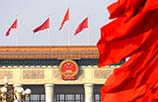Sichuan's environmental treasure go up on the big screen worldwide
By Li Yu and Peng Chao (China Daily) Updated: 2016-02-02 08:06
Province's picturesque environment showcased in latest of popular movie series, Li Yu and Peng Chao discover.
Many viewers of the movie Kung Fu Panda 3, which was released in China and the United States on Friday, are interested in the fictional Panda Village to which hero Po returns with his long-lost father, especially those who live in or have traveled to Sichuan province in southwestern China.
After watching the movie, foreign viewers told China Daily that they were keen to visit Qingcheng Mountain, because the scenery of the Panda Village amazed them.
They said Qingcheng Mountain, as portrayed in the movie, looks to have a peaceful environment. In the movie, Po says he can only find inner peace on the mountain, and the power he uses in kung fu derives from there.
"I don't know the exact reason why the director chose Qingcheng Mountain (as a basis) for the scenery but, for me, it is really a good choice," a viewer said.
Raman Hui, director of the promotional music video for Kung Fu Panda 3, said the scriptwriting team visited Sichuan many times for inspiration, as it is home to giant pandas.
"When we went to Qingcheng Mountain, the first things that came into sight were the wreathes of mist and the green forest, which are exactly what Po and his father see in the movie when they return to Panda Village," he said.
Hui said the production team marveled at the scenery on Qingcheng Mountain and thought it a perfect place on which to base Panda Village.
"Were it not for the ecological environmental protection and construction throughout the entire province in the past decades, the beautiful scenery wouldn't be possible to be shown in the movie," said Luo Jianguo, chief engineer of the Sichuan Forestry Department.
Sichuan province is a large forestry province and one of the world's 25 most important ecological zones, according to Luo.
The province has taken the lead in the country to launch a Natural Forest Protection Project. It has also started a Grain for Green project initiated by the central government, which aims to control soil erosion and restore the ecological environment by returning farmland to forests.
In another development, the Sichuan provincial government proposed to build the ecological barrier in the upper reaches of the Yangtze River for the sake of the Yangtze River Basin.
Dujiangyan, a county-level city administered by Chengdu, capital of Sichuan province and where the Qingcheng Mountain is located, is a key region for the survival and reproduction of giant pandas, as well as part of the ecological barrier in the upper reaches of the Yangtze River.
The city has enlarged the living space for its pandas by protecting the forest around the panda habitat and building a nature reserve, according to Chen Yongzhong, deputy director of the Longxi-Hongkou National Nature Reserve, one of the country's 67 giant panda reserves.
Chen said the city has returned 5,000 hectares of farmland to forest, and built the Longxi-Hongkou National Nature Reserve that covers 31,000 hectares, expanding the giant panda habitat to nearly 40,000 hectares.
"Thanks to the improving ecological environment, it is home to 14 wild pandas now, while in the past there were only six to eight," he said.
Dujiangyan is also home to a Rescue and Disease Control Center and a Field Research Center for the study of panda disease control and prevention, rescue and quarantine, rehabilitation and wilderness-survival training.
The two centers house 44 pandas that were bred in captivity. Some of those animals will be released into the wild to enlarge the wild population, according to Chen.
"Sichuan province strove to improve its ecological environment during the 12th Five-Year Plan (2011-15) ," Luo said.
By the end of 2015, the forest coverage of the province reached 36.02 percent, 14 percent points higher than the national average and 0.3 percentage point higher than in the previous year.
"Though a small number, the 0.3 percentage point means the forest area of Sichuan increased some 299,850 hectares in 2015," Luo said.
So far, Sichuan province has afforested more than 6.67 million hectares of land. Its total forest stock ranks third and forest area ranks fourth in the nation. The sediment that enters the Yangtze River every year has been reduced by 300 million metric tons, which is nearly 80 percent of the flow, during peak season in the past," according to Luo.
"Nature is the true treasure," Luo said. The ecological services provided by the province's forests and wetlands, such as water conservation and air purification, are estimated to be worth as much as 1.65 trillion yuan ($251 billion) per year.
The province has also protected more than 10,000 higher plants and 1,200 land vertebrates. Many of its endangered species, including the giant panda, have seen an increase in recovery.
According to the fourth National Panda Census released in 2015, there are 1,864 wild pandas in China, of which 1,387 are in Sichuan province.
The province has been known to the world as home to giant pandas since French priest Jean Pierre Armand David discovered and documented the animals in Baoxing county in 1869.
Located on the western edge of the Sichuan Plain, Baoxing county is an important ecological area on the upper reaches of the Yangtze River.
It covers 3,114 sq km, 99.7 percent of which is mountainous and 75 percent of which belongs to the core area for the protection of pandas.
During the 13th Five-Year Plan (2016-20), Sichuan will continue to cultivate its forest ecosystem, restore the wetland ecosystem and control the desert ecosystem and, as a result, to basically complete the construction of the ecological barrier in the upper reaches of the Yangtze River, according to Luo.
By 2020, the forest coverage of Sichuan province is expected to reach 37 percent.
Another major task for Sichuan is to enhance the protection of critically endangered wild animals, such as giant pandas and golden monkeys. The province aims to provide effective protection for 95 percent of the national or provincial key protected wild animals and plants in nature reserves.
The province also plans to build three national parks for giant pandas in Chengdu, Ya'an and Mianyang.
Experts believe that the national parks will help break administrative barriers and create a better living environment for pandas as well as other endangered wild animals.
Contact the writers at liyu@chinadaily.com.cn and pengchao@chinadaily.com.cn
|
A scene from Kung Fu Panda 3 shows the Panda Village on Qingcheng Mountain. Photos provided to China Daily |
|
Qingcheng Mountain, located to northwest of Chengdu, capital of Sichuan province, is known as a birthplace of Taoism and is famous for its peaceful natural environment. |
|
A panda in Baoxing county. French priest Jean Pierre Armand David discovered and documented the animals in Baoxing county in 1869. |
|
A Kung Fu Panda 3 promotion is held in Chengdu on Jan 20. In the new movie, Po will return to his hometown. |
|
People practice tai chi on Qingcheng Mountain. |
|
Po and a friend in the movie Kung Fu Panda 3. |
(China Daily 02/02/2016 page7)
- Nation in bid to ward off the Zika virus
- Li drops in for a chat at historic mosque
- Prison time reduced after 11 show they regret crimes
- PLA vows support, contributions to military reform
- Hainan looks to boost visitor numbers
- Excessive emissions a big problem in 59 cities
- Tough rules will cut marine pollution
- PLA revamps command system
- Teen calls for educational reform at political meeting
- Huge investment fraud ring smashed












